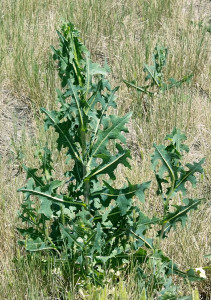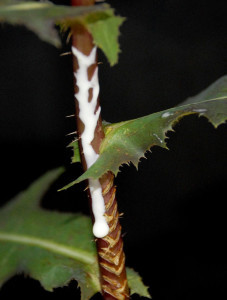This is very fresh news. One of these chairs has not yet been listed (at the time of this writing) as a member of the institute that he will be leading. Here’s the big picture news from an
April 17, 2019 University of British Columbia (UBC) news release, Note: Links have been removed,
Two internationally recognized researchers join the University of British Columbia as Canada Excellence Research Chairs, bringing international talent in the fields of forest bioproducts and precision cancer drug design.
Orlando Rojas has accepted the Canada Excellence Research Chair in Forest Bioproducts, while Sriram Subramaniam will hold the Gobind Khorana Canada Excellence Research Chair in Precision Cancer Drug Design—named after late Nobel Prize-winning UBC biochemistry professor Har Gobind Khorana.
“We are delighted to welcome Dr. Rojas and Dr. Subramaniam to UBC,” said UBC President and Vice-Chancellor, Professor Santa J. Ono. “Thanks to the CERC program and the generous support of our partners, including VGH & UBC Hospital Foundation, we have an opportunity to continue to build on UBC’s reputation as a global leader in these vitally important research fields.”
The Canada Excellence Research Chairs (CERC) program was established by the federal government in 2008 to attract top research talent from abroad to Canada. UBC will receive up to $10 million over seven years to support each chair and their research teams. In addition, a philanthropic gift of $18 million made to VGH & UBC Hospital Foundation will support cancer drug design that will be carried out by Subramaniam in close partnership with UBC and the Vancouver Prostate Centre at VGH.
“VGH & UBC Hospital Foundation is honoured to announce an $18 million gift from Aqueduct Foundation on behalf of an anonymous donor that will increase capacity for discovering and testing new life-saving cancer treatments right here in B.C. This funding will specifically support the design of precise, targeted and cost-effective drugs for cancer in work led by Dr. Sriram Subramaniam in close partnership with UBC and the Vancouver Prostate Centre at VGH and other research centres,” says Barbara Grantham, president and CEO of VGH & UBC Hospital Foundation.
Bioproducts
The April 17, 2019 UBC news release, goes on to describe the two new chairs,
Breaking new ground in forest bioproducts
Orlando Rojas comes to UBC from Aalto University [Finland], where he directs with VTT, the Technical Research Centre of Finland, a scientific cluster to advance the Finnish materials bio-economy. A recipient of the Anselme Payen Award—one of the highest international recognitions in the area of cellulose and renewable materials—and an elected member of the American Chemical Society and the Finnish Academy of Science and Letters, Rojas is recognized as a worldwide leader in the area of nanocelluloses.
“I’m thrilled to join an already stellar team of researchers at UBC’s BioProducts Institute,” said Rojas. “My research is aimed at uncovering solutions that can be found in nature to fulfill our material needs by using sustainably, readily available bio-resources. I hope to break new grounds to create positive societal impacts and to better our quality of life.”
As the CERC in Forest Bioproducts, Rojas will establish a world-class research program in genomics, synthetic biology, materials science and engineering. Together with his team and by applying cutting-edge nano- and biotechnologies, he will discover new strategies to isolate and transform biomass components—non-fossil organic materials derived from plants (including wood)—as well as side-streams and residuals from forestry and agriculture, oils and biomolecules. The work will lead to the generation of new bio-based precursors and advanced materials critical to the future bioeconomy. Rojas will be the scientific director of the UBC BioProducts Institute, synergizing a distinguished group of professors and researchers across campus who will conduct multi- and cross-disciplinary research that will position UBC at the forefront in the area.
As climate change continues to be the greatest threat to our world, the need to transition toward a more sustainable bio-based circular economy is critical. Rojas’ research is vital in understanding the role of forest and other plant-based resources in facilitating the transition to renewable materials and bioproducts.
As I noted earlier, Rojas has yet to be added to the UBC BioProducts Institute roster but I did find a listing of his published papers on Google Scholar and noted a number of them are focused on nanocellulose with at least one study on cellulose nanocrystals (CNC),
- Cellulose nanocrystals: chemistry, self-assembly, and applications [by] Y Habibi, LA Lucia, OJ Rojas Chemical reviews 110 (6), 3479-3500
The University of British Columbia was the site for much of the early work in Canada and internationally on cellulose nanocrystals. After the provincial government lost interest in supporting it, the researchers at FPInnovations (I think it was a university spin-off organization) moved their main headquarters (leaving a smaller group in British Columbia) to the province of Québec where they receive significant support . In turn, FPInnovations spun-off a company, CelluForce which produces CNC from forest products.This news about Roja’s appointment would seem to make for an interesting development in Canada’s nanocellulose story.
Precision medicine with cryo-electron microscopy
Now for the second CERC appointment, from the April 17, 2019 UBC news release,
Putting Canada at the forefront of precision medicine
Sriram Subramaniam is recognized as a global leader in the emerging field of cryo-electron microscopy, or cryo-EM, a technology that has sparked a revolution in imaging of protein complexes. Subramaniam and his team demonstrated that proteins and protein-bound drugs could be visualized at atomic resolution with cryo-EM, paving the way for this technology to be used in accelerating drug discovery.
Subramaniam comes to UBC’s faculty of medicine from the US National Cancer Institute (NCI) at the National Institutes of Health (NIH) where he led a research team that made seminal advances in molecular and cellular imaging using electron microscopy, including work on advancing vaccine design for viruses such as HIV. Subramaniam is also founding director of the National Cryo-EM Program at NCI, NIH.
As the Gobind Khorana Canada Excellence Research Chair in Precision Cancer Drug Design, Subramaniam will establish and direct a laboratory located at UBC, aimed at bringing about transformative discoveries in cancer, neuroscience and infectious disease. Subramaniam is appointed both in the department of urologic sciences and in biochemistry and molecular biology at UBC, and is linked to the precision cancer drug design program at the Vancouver Prostate Centre at VGH.
His research is supported by a philanthropic gift of $18 million made to VGH & UBC Hospital Foundation. He will work in close partnership with the Vancouver Prostate Centre at VGH.
“We would not be able to undertake this path aimed at leveraging advances in imaging technology to improve patient outcomes if it weren’t for the generous support of the donor, the Canadian government, and VGH & UBC Hospital Foundation,” said Subramaniam. “I am proud to be part of a team of outstanding researchers here in Vancouver, and working together to harness the true potential of cryo-EM to accelerate drug design. Our work has the potential to establish VGH, UBC and Canada at the forefront of the emerging era of precision medicine.”
I was not able to find much in the way of additional information about Subramaniam—other than this (from the High Resolution Electron Microscopy Lab Members webpage),
Sriram Subramaniam received his Ph.D. in Physical Chemistry from Stanford University and completed postdoctoral training in the Departments of Chemistry and Biology at M.I.T. [Massachusetts Institute of Technology] He is chief of the Biophysics Section in the Laboratory of Cell Biology at the Center for Cancer Research, National Cancer Institute. He holds a visiting faculty appointment at the Johns Hopkins University School of Medicine.
Welcome to both Orlando J. Rohas and Sriram Subramaniam!

